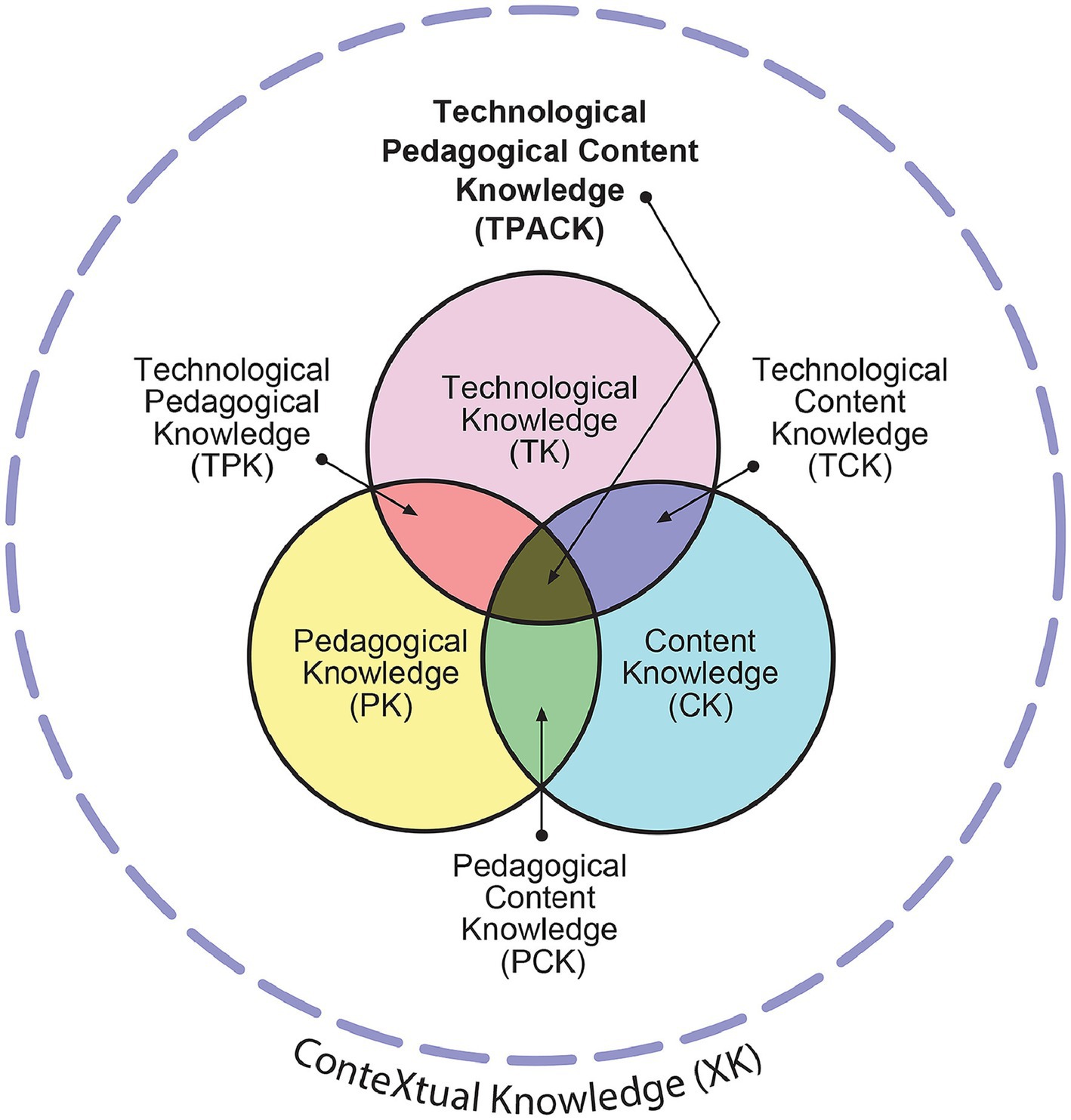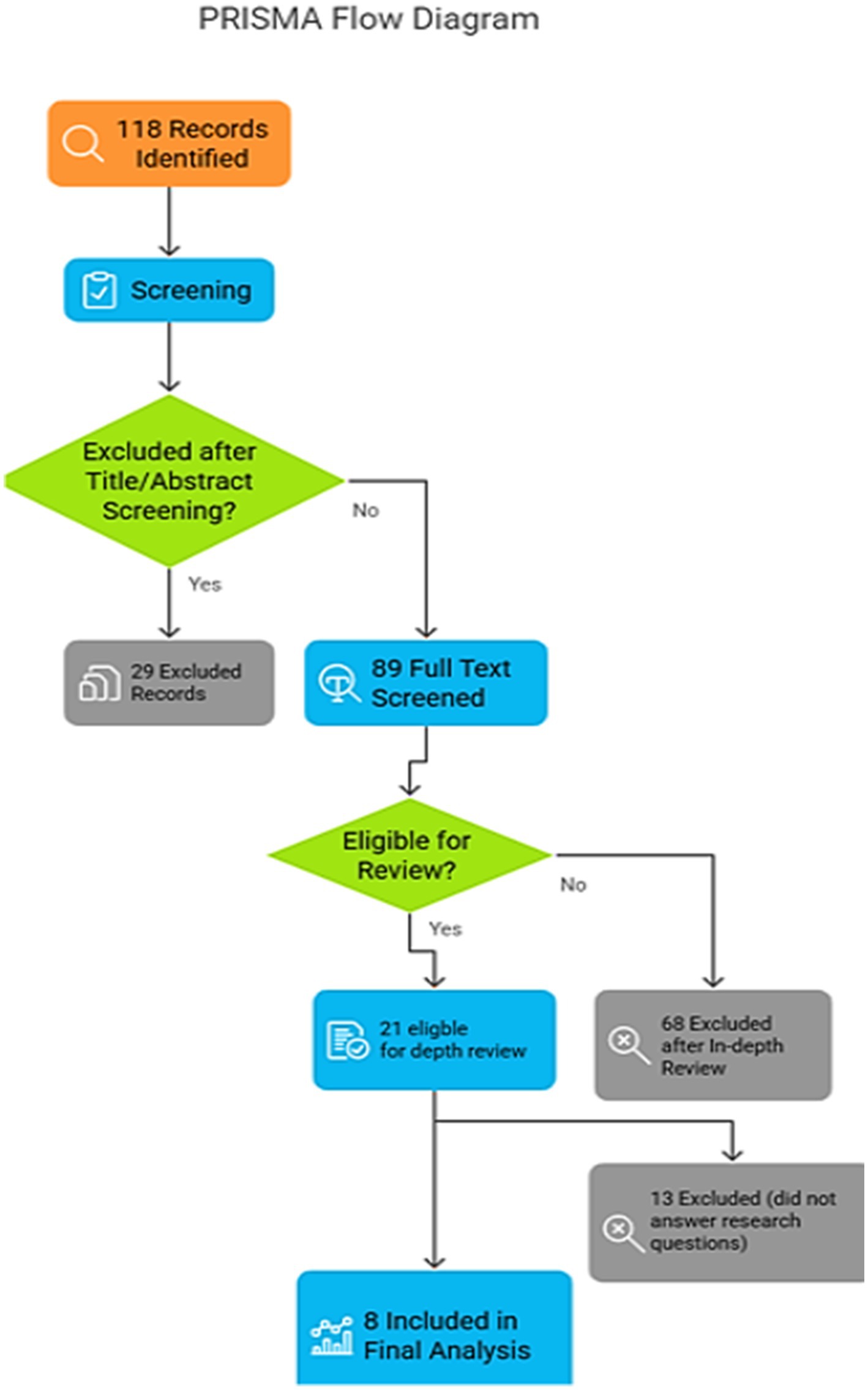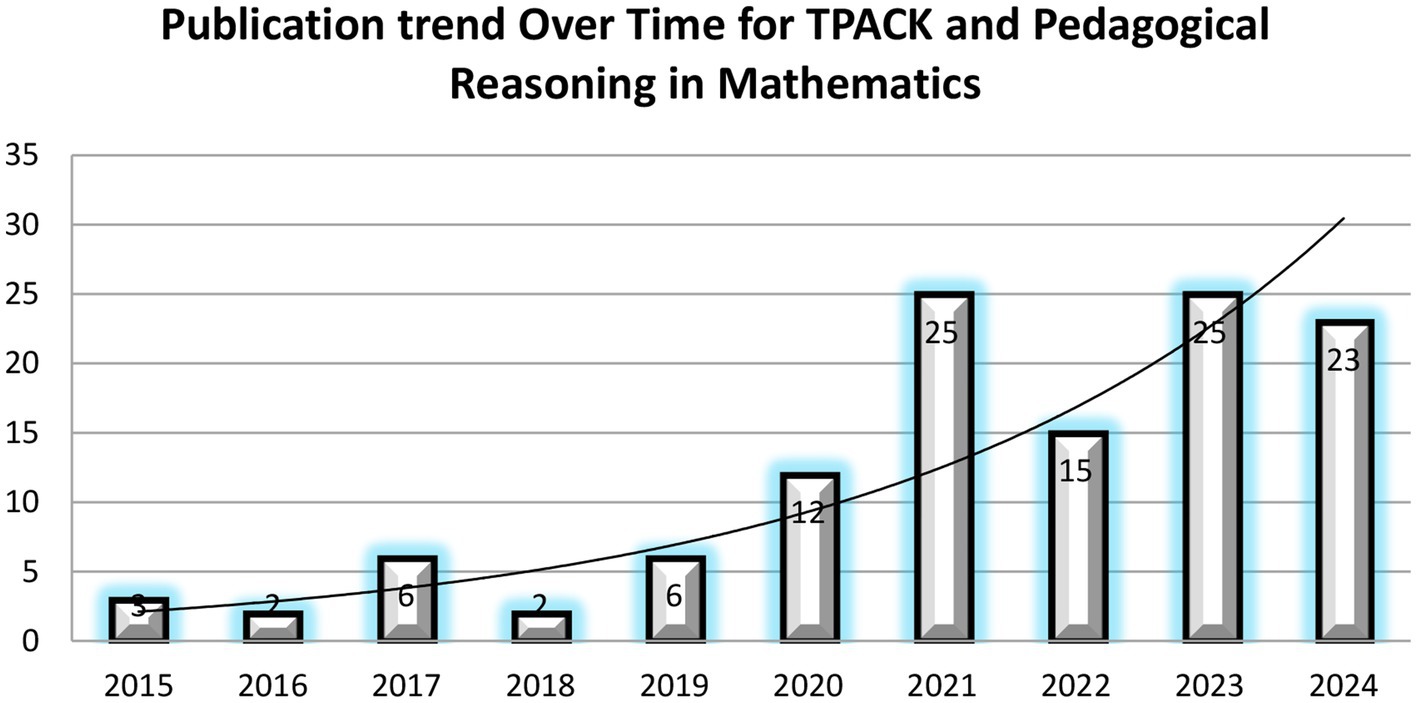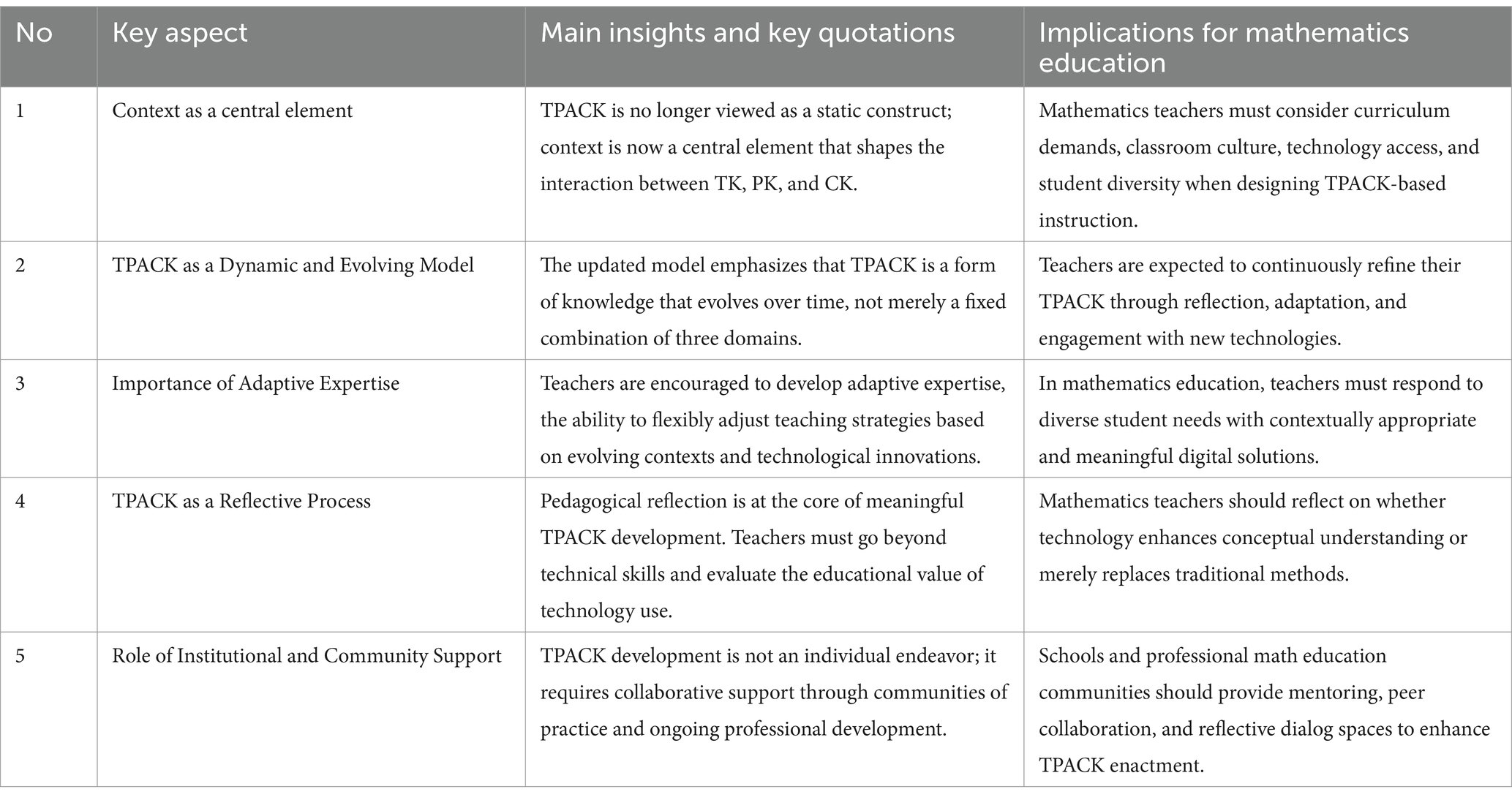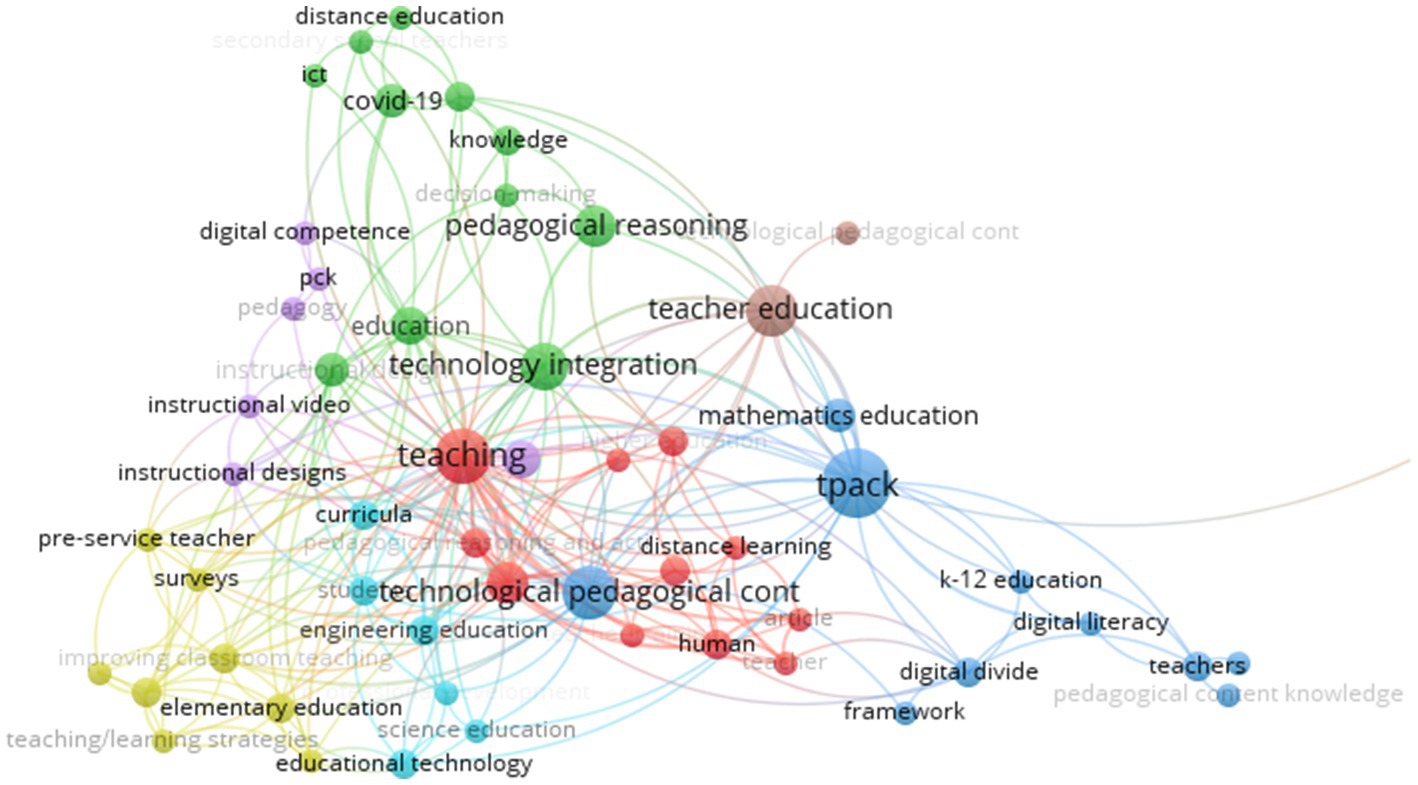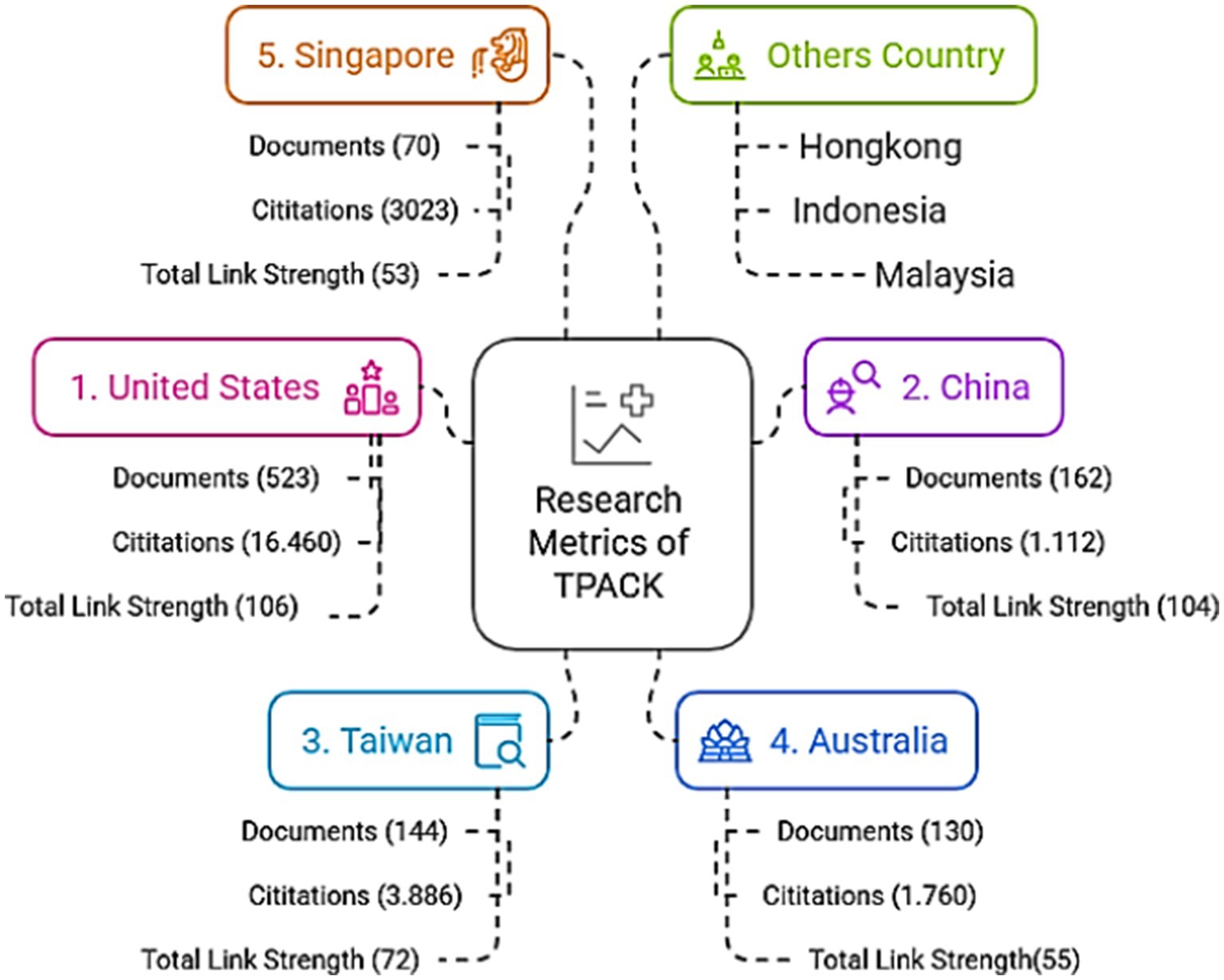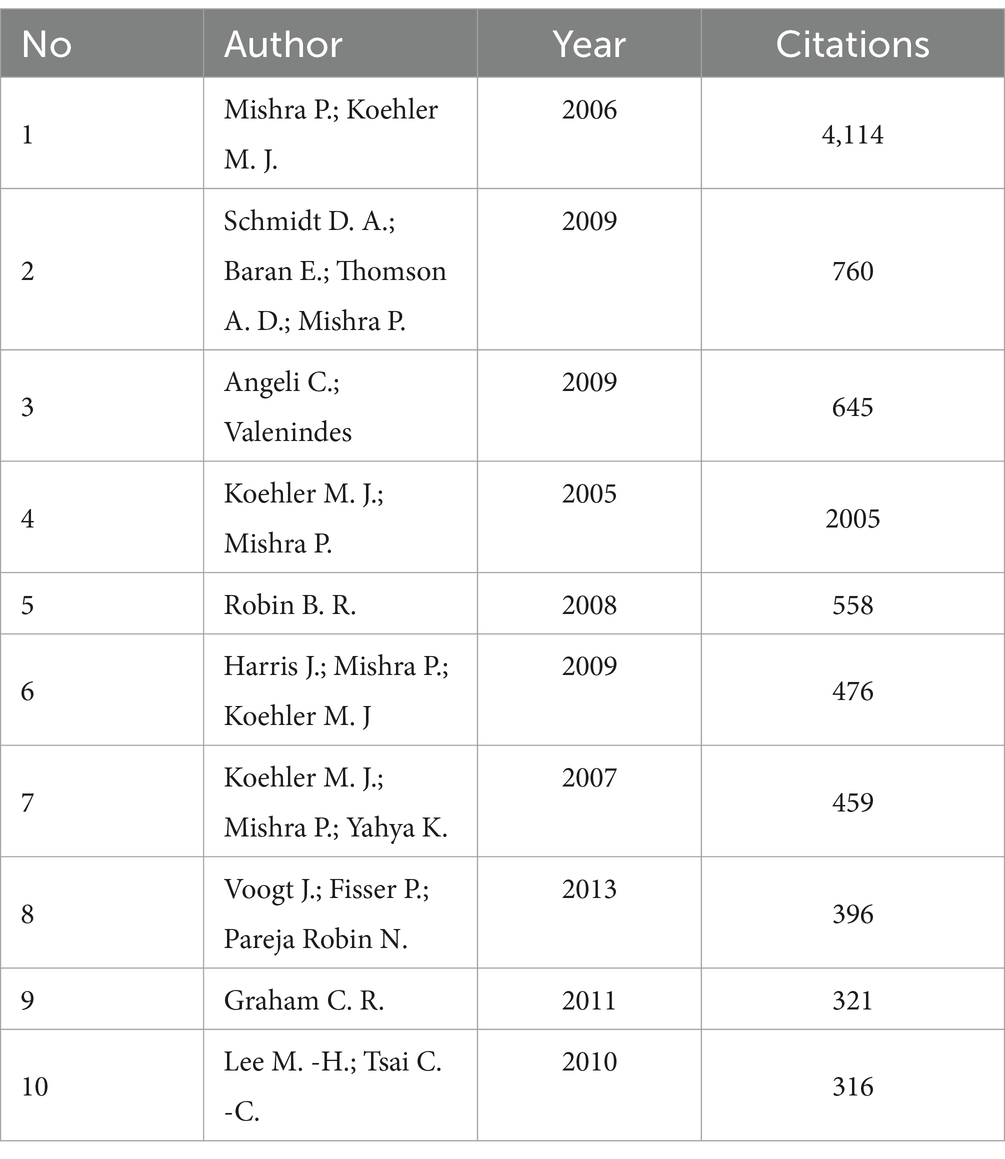- 1Department of Mathematics Education, Universitas Pendidikan Indonesia, Bandung, Indonesia
- 2Department of Mathematics Education, Universitas Samudra, Langsa, Indonesia
- 3Department of Mathematics, National Taiwan Normal University, Taipei, Taiwan
Effective integration of technology in mathematics education requires teachers to blend content knowledge, pedagogical strategies, and digital tools. The Technological Pedagogical Content Knowledge (TPACK) framework offers a lens for understanding teachers’ pedagogical reasoning when designing technology-enhanced lessons. However, the ways in which TPACK informs instructional planning and the challenges educators face remain under - synthesized. A systematic review following PRISMA guidelines was conducted using Scopus (2015–2024). Search terms included “pedagogical reasoning,” “instructional reasoning,” “TPACK,” and “math*.” From 118 records retrieved, title/abstract screening and full - text eligibility assessments yielded eight empirical studies examining TPACK and pedagogical reasoning in mathematics contexts. The included studies employed predominantly qualitative case studies and mixed - methods designs to capture teachers’ decision - making processes. Findings indicate that educators leverage TPACK to enhance conceptual understanding and student engagement via dynamic visualizations, interactive simulations, and scaffolded digital tasks. Common obstacles include limited subject - specific professional development, resource constraints, and heterogeneity in teachers’ TPACK proficiency. Evidence also highlights TPACK’s capacity to foster inquiry - based learning and develop teachers’ adaptive expertise. Sustained, targeted professional development and equitable access to technology are essential for deepening TPACK enactment. Implications for practice include designing PD programs that integrate subject - specific technology applications and creating institutional support structures. Future research should investigate longitudinal impacts of TPACK on teachers’ reflective practices and student outcomes, and develop standardized assessment tools tailored to mathematics instruction.
1 Introduction
The role of technology in education has significantly expanded in recent decades, becoming an integral part of teaching and learning across disciplines. In mathematics education, where conceptual understanding and analytical thinking are central, the integration of technology presents unique opportunities to enhance student engagement and deepen comprehension. However, successful technology integration requires more than just access to digital tools; it demands a structured approach that effectively combines technological tools with subject content and pedagogical strategies. The Technological Pedagogical Content Knowledge (TPACK) framework, developed by Mishra and Koehler (2006), and lately renewed by Petko et al. (2025) provides this integrated approach by emphasizing the intersection of content knowledge, pedagogical knowledge, and technological knowledge.
A solid understanding of TPACK equips teachers to design effective and engaging instructional experiences, while also facilitating improved communication and collaboration among educators, students, and parents (McDougall and Phillips, 2024; Petko et al., 2025; Yeh et al., 2021). Through digital platforms, teachers can share learning resources, evaluation results, and instructional ideas, supporting both transparency and collaborative teaching practices. This openness not only strengthens school-wide learning communities but also supports student learning outcomes. Furthermore, TPACK builds upon Shulman’s Pedagogical Content Knowledge (PCK) model (Shulman, 1986), enriching it with the technological dimension to meet the demands of 21st-century classrooms (Mishra et al., 2022; Özen and Kurtuluş, 2023). As such, TPACK offers a comprehensive lens through which educators can navigate the complexities of teaching with technology, particularly in specialized fields like mathematics.
1.1 TPACK framework: relevance and components
In the context of mathematics education, the TPACK framework is particularly valuable, as mathematics often involves abstract concepts that can be challenging for students to grasp through traditional instruction alone. When properly integrated, technology can offer powerful visualizations, interactive simulations, and immediate feedback that facilitate deeper conceptual understanding. However, using technology effectively requires teachers not only to be proficient with digital tools but also to understand how to align these tools with mathematical content and pedagogical strategies (Shi et al., 2019). The TPACK framework thus helps mathematics educators balance these elements, allowing for a thoughtful and intentional approach to technology integration.
Recent developments in TPACK research emphasize the dynamic and contextual nature of the framework (Petko et al., 2025). Rather than viewing the three domains as fixed entities, its current perspective emphasizes that teachers must continually adapt their knowledge to evolving classroom needs and emerging technologies. The updated model also highlights the importance of contextual factors, such as school infrastructure, student diversity, and teacher beliefs, that influence how TPACK is enacted in practice.
The framework encompasses seven interrelated domains: technological knowledge (TK), content knowledge (CK), pedagogical knowledge (PK), pedagogical content knowledge (PCK), technological content knowledge (TCK), technological pedagogical knowledge (TPK), and the integrated domain of technological pedagogical content knowledge (TPACK) itself (Schmidt et al., 2009; Graham et al., 2012). These components represent the complex knowledge that teachers need to design meaningful technology-enhanced learning environments. Consistent with recent insights by Petko et al. (2025), effective TPACK development also requires teachers to engage in ongoing reflection and adaptive reasoning. Teachers are encouraged to move beyond the technical use of tools and consider how technology mediates the learning process and supports higher-order thinking.
Petko et al. (2025) argue that teachers’ pedagogical reasoning processes must involve critical reflection on how digital tools mediate content and learning interactions. For mathematics educators, this means questioning not only what technology is used, but also how and why it is used in a way that enhances students’ conceptual understanding. Teachers are thus encouraged to develop adaptive expertise, which allows them to navigate new technologies, select contextually appropriate tools, and modify their strategies based on formative feedback and student needs. The following section summarizes key updates from Petko et al. (2025), which extend the traditional TPACK model and offer critical implications for mathematics education.
Recent developments in teacher knowledge models, particularly Pedagogical Content Knowledge (PCK), have shifted toward a process-based and enacted perspective. The updated PCK framework includes a range of dimensions such as student knowledge, curricular and assessment knowledge, collective PCK (cPCK), personal PCK (pPCK), and enacted PCK (ePCK), encompassing planning, instruction, reasoning, and reflection. In parallel, the TPACK framework has also evolved to emphasize its contextual and dynamic nature. As proposed by Petko et al. (2025), the updated model introduces “Contexts” and “Contextual Knowledge (XK)” as essential elements that influence how TPACK is developed and enacted in practice. These additions underscore the idea that teachers’ technological, pedagogical, and content knowledge must be understood in relation to the specific educational environments in which they operate. Contextual Knowledge, in particular, differentiates expert teachers from novices by enabling flexible adaptation and reflective decision-making in diverse classroom settings. The updated TPACK framework proposed by Petko et al. (2025) is displayed in Figure 1.
The updated TPACK framework represented in Figure 1 underscores the need for teachers to develop adaptive expertise, adaptive teaching expertise is deemed a primary goal to be pursued in a teacher-education program, learning (to teach) is likely to emphasize the ability to adapt to new instructional situations and to generate fresh ideas to address emerging pedagogical challenges (Hong and Chai, 2017). Undoubtedly, adaptive expertise in mathematics teaching is an important educational goal for teacher preparation and development (Russ et al., 2011). The ability to flexibly align technological and pedagogical choices with specific classroom needs and conditions. Particularly in mathematics education, contextual responsiveness becomes essential, as teaching practices often vary based on school resources, student backgrounds, and curricular expectations. The inclusion of contextual knowledge reinforces the understanding that effective TPACK enactment is not just a technical task, but a reflective and situated practice.
1.2 Challenges in developing TPACK for mathematics educators
While the TPACK framework provides a comprehensive model for integrating technology, pedagogy, and content, its practical application in mathematics education presents several challenges. Many mathematics educators encounter difficulties in merging technological tools with pedagogical strategies and content knowledge effectively. Research indicates that simply acquiring technological skills is not sufficient; teachers also need to understand how to utilize these tools in ways that enhance mathematical thinking and understanding (Niess, 2015). Moreover, the rapid evolution of educational technology requires continuous adaptation, making it challenging for teachers to keep their TPACK skills current.
One major challenge is the lack of targeted professional development that addresses the specific needs of mathematics teachers in developing TPACK. Studies have shown that general technology training often overlooks subject-specific applications, leaving mathematics educators with limited guidance on how to apply TPACK concepts to complex mathematical content (Hill and Uribe-Florez, 2020). Effective professional development must not only introduce technological tools but also demonstrate how these tools can support the unique pedagogical goals of mathematics education, such as fostering procedural fluency and conceptual understanding. Additionally, teachers frequently report a lack of time and institutional support to engage in meaningful professional development, which further hinders their ability to integrate technology effectively (Widiana and Rosy, 2021).
Integrating technology with mathematical content is inherently complex due to the abstract nature of mathematics. Teachers must find ways to use technology not only as a demonstration tool but also as a means to engage students actively in mathematical reasoning. For example, graphing calculators, dynamic geometry software, and computer algebra systems offer potential for visualizing abstract concepts, yet they require substantial expertise to be used effectively. Mathematics educators often need to develop specialized skills to interpret and convey mathematical ideas through these tools in ways that make the content accessible to students. This complexity is compounded by the need to tailor technological applications to students’ varying levels of mathematical understanding and technological proficiency.
Mathematics teachers exhibit varying levels of technological proficiency, which presents a challenge for implementing TPACK consistently across different educational settings. For some teachers, mastering the use of educational technology itself can be daunting, especially if they have limited prior experience with digital tools (Niess, 2015). This variability requires differentiated support, as novice technology users may need foundational training before they can begin to integrate TPACK effectively, while more experienced users might benefit from advanced strategies for enhancing pedagogical reasoning (Darling-Hammond, 2020). Research emphasizes that successful TPACK development programs should consider teachers’ existing skill levels and provide scaffolding accordingly (Seng et al., 2022). Resource constraints and access to technology also hinder TPACK development among mathematics educators. While the TPACK framework assumes access to digital tools, the reality is that many schools lack sufficient resources, particularly in underfunded regions (Widiana and Rosy, 2021). Even when technology is available, inconsistent access can prevent teachers from practicing and refining their TPACK skills. Furthermore, outdated equipment or limited access to software updates may restrict teachers’ ability to keep pace with technological advancements. This challenge underscores the importance of institutional support and equitable access to resources to facilitate TPACK development in mathematics education.
Finally, developing TPACK in mathematics education is an ongoing process that requires reflection and adaptive expertise. As new technologies emerge, teachers must continually reassess their instructional practices to determine the most effective ways to integrate digital tools with pedagogy and content. This reflective practice is essential for developing adaptive expertise, enabling teachers to respond flexibly to different instructional contexts and student needs. Research emphasizes that fostering reflective habits can help teachers build stronger TPACK skills over time, supporting sustained technology integration in mathematics classrooms.
1.3 Pedagogical reasoning and TPACK in mathematics instruction
In addition to understanding the individual components of TPACK, it is crucial to consider the process of pedagogical reasoning, which underpins teachers’ decision-making and instructional design choices. Pedagogical reasoning, a concept introduced by Shulman (1987), refers to the thought processes that teachers engage in when planning, enacting, and reflecting on instruction. It involves the transformation of content knowledge into forms that are pedagogically powerful and comprehensible to students. In the context of TPACK, pedagogical reasoning extends to the ways in which teachers integrate technology into this transformation process, considering not only the appropriateness of the technology for the content but also its pedagogical implications.
For mathematics educators, effective pedagogical reasoning within the TPACK framework involves selecting and using technologies that align with mathematical concepts and practices. For example, teachers may reason about the effectiveness of using computer algebra systems to explore algebraic structures or dynamic modeling tools to visualize calculus concepts. This type of reasoning is critical, as it allows teachers to move beyond surface-level technology use and engage students in deeper, more interactive learning experiences. However, research suggests that many teachers struggle with this level of integration, often defaulting to more traditional, teacher-centered approaches when using technology (Kimmons et al., 2020). Thus, understanding how teachers engage in pedagogical reasoning within the TPACK framework is a vital area of inquiry, particularly in mathematics education. Given the importance of TPACK in contemporary mathematics education and the complexities associated with its implementation, a systematic review of the literature is both timely and necessary. Previous research has examined various aspects of TPACK, such as its development through professional learning programs (Angeli and Valanides, 2009, 2015), its impact on student learning outcomes (Trust et al., 2016), and its application in different subject areas (Mayer and Girwidz, 2019). However, there remains a lack of comprehensive synthesis focusing specifically on TPACK as it relates to pedagogical reasoning in mathematics education.
The objectives of this systematic review are threefold:
1. To analyze how pedagogical reasoning is conceptualized and operationalized in the context of TPACK within mathematics education.
2. To identify and evaluate the methodologies used in researching TPACK-based instructional design in mathematics, including their effectiveness and limitations.
3. To synthesize the impacts of TPACK integration on mathematics teachers’ instructional planning, teaching practices, and student outcomes.
To achieve these objectives, this study addresses the following research questions:
1. How is pedagogical reasoning conceptualized and operationalized in the context of TPACK in mathematics education?
2. What methodologies are used to investigate TPACK-based instructional design in mathematics, and how effective are they in understanding teacher practices?
3. What impacts does TPACK integration have on mathematics teachers’ instructional planning and student outcomes?
This systematic review holds significant implications for both research and practice. By synthesizing the current state of knowledge on TPACK and pedagogical reasoning in mathematics, this study provides a foundation for future research that aims to deepen understanding in this area. For mathematics educators, insights from this review can inform the design and implementation of professional development programs that better support the integration of technology into teaching practices. Additionally, this review highlights areas where further research is needed, such as the long-term impact of TPACK on pedagogical reasoning and the contextual factors that influence teachers’ ability to integrate technology effectively. The findings from this review are also relevant for policymakers and educational leaders who are responsible for supporting technology integration in schools. As education systems continue to adopt digital tools and platforms, understanding the intricacies of TPACK in mathematics education will be essential for creating policies and initiatives that align with teachers’ professional needs and students’ learning outcomes. Ultimately, this review aims to contribute to a more nuanced and practical understanding of TPACK, enabling mathematics educators to navigate the challenges of technology integration with greater confidence and skill. The remainder of this paper is structured as follows. Section 2 provides the theoretical framework which are the base of this review. Section 3 outlines the methodology used to conduct the systematic review, including the search strategy, inclusion criteria, and data analysis procedures. Section 4 presents the findings, categorized by themes related to TPACK development, pedagogical reasoning processes, and instructional outcomes. Section 5 discusses the identified the implications for practice, while Section 6 offers concluding remarks and recommendations for future research.
2 Theoretical framework
In the context of mathematics education, the integration of technology into teaching is not merely a technical matter but rather a complex interplay of knowledge domains. The Technological Pedagogical Content Knowledge (TPACK) framework has become an influential model for understanding this complexity, offering a structured approach to examine how teachers can effectively blend content knowledge, pedagogical knowledge, and technological knowledge to enhance student learning outcomes. This section provides an in-depth exploration of the TPACK framework, emphasizing its components, the role of pedagogical reasoning, and the relevance of TPACK in mathematics education. By establishing a theoretical foundation, this section underscores the significance of TPACK for research on instructional design and technology integration.
2.1 Pedagogical reasoning within the TPACK framework
Pedagogical reasoning, initially conceptualized by Shulman (1987), involves the process by which teachers transform their content knowledge into forms that are comprehensible and meaningful to students. Within the TPACK framework, pedagogical reasoning is particularly complex, as it requires the integration of content, pedagogy, and technology. Teachers must not only decide how to present content and engage students but also consider which technological tools can enhance the learning experience and how to align those tools with both pedagogical goals and content requirements. In mathematics education, this process involves deliberate choices about how technology can support conceptual understanding, problem-solving skills, and procedural fluency.
The stages of pedagogical reasoning comprehension, transformation, instruction, evaluation, reflection, and new comprehension each play a critical role within TPACK. In the comprehension stage, teachers develop an in-depth understanding of mathematical concepts, which then informs how they will integrate technology to make these concepts accessible to students. The transformation stage, where content is adapted into teachable forms, requires that teachers understand both the capabilities and limitations of digital tools and how these tools can concretely illustrate abstract mathematical ideas. For instance, dynamic geometry software can support the visualization of geometric transformations, providing students with interactive experiences that would be challenging to replicate through traditional instruction alone (Bokosmaty et al., 2017).
2.1.1 Transforming content through technology for mathematical comprehension
One of the unique challenges of pedagogical reasoning within TPACK is transforming content through technology to foster deep mathematical understanding. Teachers must carefully choose tools that not only align with the mathematical content but also enhance students’ ability to explore, hypothesize, and test their understanding (Abrahamson et al., 2020). For example, in teaching calculus, graphing software can enable students to visualize the behavior of functions, such as limits and asymptotes, providing an experiential understanding of these concepts. This transformation process requires teachers to think critically about how the chosen technology influences students’ engagement and learning outcomes, as well as how to guide students in using the technology effectively (Niess and Gillow-Wiles, 2017; Voogt et al., 2013). Research underscores that successful transformation within TPACK requires a nuanced understanding of students’ prior knowledge, cognitive development, and potential misconceptions (Hoth et al., 2022). For instance, teachers need to anticipate common errors in mathematical reasoning when students use technology to explore patterns or solve problems. By predicting and addressing these issues, educators can use technology as a scaffold, enhancing students’ comprehension without allowing the technology to overshadow the mathematical principles being taught.
Instruction within the TPACK framework involves delivering content in a way that fully utilizes technology’s potential to engage students actively. This stage requires that teachers not only present information but also facilitate hands-on activities, provide immediate feedback, and foster collaborative problem-solving (Demirhan and Şahin, 2021). In mathematics, instructional methods within TPACK often incorporate simulations, data analysis tools, and interactive software to allow students to explore complex ideas in depth. For instance, teachers may use statistical software to teach data handling, enabling students to visualize data patterns and apply statistical concepts in real-time.Reflection is a pivotal part of pedagogical reasoning in TPACK, as it allows teachers to evaluate the effectiveness of technology integration and make adjustments as needed. Reflective practice helps educators understand which aspects of their instructional design worked well and which need refinement, particularly in terms of technology’s role in facilitating mathematical understanding. This iterative process of reflection and adaptation is essential for teachers to build adaptive expertise, as they learn to modify their approaches based on student feedback, learning outcomes, and evolving technological options. Studies suggest that regular reflection on TPACK-based instruction can help teachers identify more effective ways to align technology with both content and pedagogy over time (Kimmons et al., 2020; Seng et al., 2022). However, behind all that, the teacher’s awareness plays an important role in the teaching process. The use of technology in teaching requires teacher’s awareness of how technology can be used as an appropriate mode. Particularly in mathematics, teachers’ awareness of the mental processes that characterize strong mathematical schemas can contribute to their ability to reorganize their content knowledge into a form that can be transformed to support effective teaching practices (Tallman, 2021). This is what motivates us to explore teachers’ pedagogical reasoning using the TPACK framework, with the objective of using appropriate and relevant technology in mathematics learning.
Evaluation is another key component of pedagogical reasoning within TPACK, involving assessment of both student learning outcomes and the effectiveness of technology integration. Mathematics teachers must consider not only whether students have mastered the content but also how technology contributed to or potentially hindered the learning process (Hoth et al., 2022). Effective evaluation in TPACK requires the use of formative assessments, such as interactive quizzes or technology-mediated feedback tools, to gauge student understanding continually. This real-time feedback allows teachers to adjust instruction to meet students’ needs, helping to ensure that technology is enhancing, rather than distracting from, the learning goals (You et al., 2019).
2.2 TPACK and mathematics education
The application of TPACK in mathematics education has shown promising results in enhancing both teaching practices and student learning outcomes. Research suggests that when mathematics teachers effectively integrate TPACK, they are able to create instructional experiences that promote conceptual understanding, critical thinking, and problem-solving skills (König et al., 2022; Niess, 2005; Özen and Kurtuluş, 2023). For instance, dynamic geometry software has been shown to facilitate students’ understanding of geometric transformations and relationships, while data analysis tools allow students to explore statistical concepts through interactive visualizations. However, the development of TPACK in mathematics education also presents challenges. Studies indicate that many teachers struggle with integrating technology in ways that align with both pedagogical goals and content-specific requirements (Herro et al., 2021). This is particularly true in mathematics, where the abstract nature of the subject can make it difficult to find appropriate technological tools. Furthermore, mathematics teachers may lack access to professional development programs that focus specifically on building TPACK, leading to uneven levels of technological integration across classrooms.
The TPACK framework has become a pivotal model for guiding technology integration in mathematics education, where the alignment of technological, pedagogical, and content knowledge is particularly essential due to the unique cognitive demands of the subject. Mathematics education involves not only supporting students’ but also the cultivation of abstract thinking and problem-solving skills. The effective use of technology within this domain enables teachers to create dynamic, interactive learning environments that can support students in visualizing complex mathematical concepts and developing a more profound understanding of the content. For example, tools like dynamic geometry software and graphing calculators offer interactive visualizations, enabling students to explore mathematical properties and relationships that are often challenging to convey through traditional instruction alone (Kunwar and Laxmi, 2023).
Research has shown that TPACK-based technology integration can enhance both engagement and achievement in mathematics education, especially when tools are used to facilitate hands-on exploration, model real-world problems, and encourage inquiry-based learning. By integrating TPACK, mathematics teachers can utilize digital resources to scaffold instruction, allowing students to experiment, make predictions, and verify their hypotheses in real time. For instance, when teaching functions, teachers might employ graphing software to help students visualize how changes in function parameters affect graph shape and behavior. This type of technology-enhanced learning fosters conceptual understanding by encouraging students to engage directly with the mathematical structures (Yang et al., 2021).
The integration of TPACK can also address the challenges of teaching complex mathematical concepts, such as calculus and probability, by allowing students to interact with simulations and visual models. Studies suggest that such technology-supported approaches can improve students’ retention and transfer of knowledge, as students are better able to connect mathematical theory to practical applications. Moreover, by encouraging students to use technology as a problem-solving tool, teachers help them develop a toolkit of resources that can be applied across different mathematical contexts, reinforcing both conceptual and procedural understanding.
Mathematical communication-explaining reasoning, justifying answers, and collaborating on problem- solving is a crucial skill in mathematics education that TPACK can significantly enhance. Through collaborative tools like interactive whiteboards, online discussion forums, and shared digital platforms, teachers can create environments where students actively engage with mathematical ideas, discuss their reasoning, and critique each other’s work (Webb et al., 2019). These activities are essential for developing critical thinking and are aligned with the pedagogical goals of mathematics education, which emphasize reasoning and argumentation alongside computation.
Research shows that technology-supported collaborative learning can foster deeper engagement with mathematical content by promoting peer-to-peer interaction and dialog, which are key to understanding complex concepts. For example, interactive tools that allow students to manipulate and annotate geometric figures collaboratively provide opportunities for them to share ideas and refine their thinking through discussion. In a TPACK context, such tools enable teachers to structure learning activities that support collaboration, thereby enhancing students’ ability to articulate and defend their mathematical reasoning (Rakes et al., 2022).
Reflective practice is integral to developing strong TPACK, as it enables mathematics teachers to evaluate the effectiveness of technology integration continuously. By reflecting on their instructional practices, teachers can assess how well their use of technology supports student learning and make adjustments to improve outcomes. Research suggests that teachers who regularly engage in reflective practice are better able to adapt their instructional strategies to align with students’ evolving needs, which is crucial for fostering a responsive and inclusive learning environment in mathematics. Professional development programs that promote reflective habits can help teachers refine their TPACK, building adaptive expertise that enables them to integrate technology in a way that consistently enhances mathematics instruction.
2.3 Significance of TPACK for teacher education and professional development
The TPACK framework provides a valuable structure for guiding teacher education and professional development in mathematics. By focusing on the intersections of content, pedagogy, and technology, TPACK-based professional development programs can help teachers acquire the integrated knowledge needed to teach effectively with digital tools. Research has shown that TPACK training can improve teachers’ confidence and competence in using technology, leading to more effective instructional practices (Martin, 2015; Rakes et al., 2022). In mathematics education, TPACK-focused professional development might include workshops on specific software tools, collaborative lesson planning sessions, and opportunities for teachers to reflect on their technology use. Such programs are essential for helping mathematics educators navigate the complexities of technology integration and develop a nuanced understanding of how digital tools can support mathematical learning.
The TPACK framework serves as a foundational model for understanding the knowledge and skills required to integrate technology into mathematics education. By examining the intersections of content, pedagogy, and technology, TPACK provides a comprehensive framework for exploring how teachers can use digital tools to enhance mathematical instruction. This theoretical foundation supports the objectives of this systematic review, which aims to investigate how TPACK is conceptualized, developed, and applied in mathematics education. In the following sections, we will explore the methodology used to conduct this review and present findings related to TPACK’s impact on pedagogical reasoning, instructional design, and student learning outcomes in mathematics.
3 Methodology
This study employed a systematic review approach guided by the PRISMA (Preferred Reporting Items for Systematic Reviews and Meta-Analyses) protocol (Page et al., 2021). The review process included four main stages: identification, screening, eligibility assessment, and final inclusion. Each stage followed established guidelines to ensure transparency, rigor, and reproducibility.
3.1 Identification
The identification phase involved a comprehensive search of the Scopus database, using keywords and Boolean operators designed to capture relevant studies on pedagogical reasoning, technology-based instructional design, and mathematics education. The search terms were carefully constructed as follows:
1. Search Terms
2. (“pedagogical reasoning” OR “teacher reasoning” OR “instructional reasoning”) AND (“TPACK” OR “TPCK”) AND (“math*”)
3. Database: Scopus
4. Filters: The search was limited to peer-reviewed journal articles, book chapters, and conference papers published within 2015 to 2024 with focus on recent developments.
This search retrieved a total of 118 records. All records were imported into a reference management software, and duplicates were removed.
3.2 Screening
An initial pool of 118 articles was retrieved. After screening the titles and abstracts, 29 articles were excluded based on the following criteria:
1. Irrelevance to the pedagogical component,
2. Discussion of technology integration without referencing the TPACK framework or pedagogical reasoning,
3. Full-text not accessible,
4. Not published in English.
This screening stage resulted in 89 articles eligible for full-text review.
3.3 Eligibility
The full-text review of the remaining 89 articles was conducted to evaluate their relevance to the research objectives. Articles were considered eligible if they met the following inclusion criteria:
1. Explicit use of the TPACK framework in analyzing teacher pedagogical reasoning or instructional design.
2. Focus on mathematics education, particularly with empirical data on planning and implementing technology-based instructional design.
3. Studies that addressed teacher reasoning, decision-making, or instructional strategies in the context of TPACK.
As a result, 21 articles met the eligibility criteria.
3.4 Inclusion
After a thorough evaluation of the 21 eligible studies, 13 articles were excluded due to insufficient alignment with the research questions. Specifically, these studies lacked depth in addressing pedagogical reasoning within the TPACK framework or did not provide empirical insights relevant to mathematics instruction. Thus, 8 studies were included in the final analysis for this systematic review.
3.5 PRISMA flow diagram
A PRISMA flow diagram is displayed in Figure 2. This diagram illustrates the four-stage review process (identification, screening, eligibility, and inclusion) followed in accordance with PRISMA guidelines. It provides a transparent account of the number of records retrieved, excluded, and finally included in the review of TPACK and pedagogical reasoning in mathematics education.
4 Result and discussion
This section discusses each research question based on the findings of the systematic review, presenting synthesized insights and implications related to the TPACK framework, pedagogical reasoning, and mathematics education. The following are the research findings included in the final analysis used in answering the research questions.
4.1 Conceptualizing and operationalizing pedagogical reasoning in the context of TPACK in mathematics education
Pedagogical reasoning within the TPACK framework is conceptualized as an iterative process through which teachers interpret and transform mathematical content to make it accessible to students using technology. This process involves multiple stages: understanding the content, choosing appropriate technological tools, transforming instructional strategies, delivering lessons, evaluating learning outcomes, and reflecting on effectiveness (Shulman, 1987). Operationalization of pedagogical reasoning within TPACK often requires teachers to adapt their instructional practices according to students’ needs and technology affordances. Studies show that teachers use pedagogical reasoning to evaluate when and how to introduce technology in ways that deepen students’ understanding without overwhelming them with extraneous elements (Janson et al., 2020). This includes structuring lessons so that technology acts as a scaffold, supporting problem-solving and conceptual learning. Research emphasizes that successful operationalization of pedagogical reasoning depends on teachers’ reflective practices and adaptive expertise, both of which are enhanced through ongoing professional development (Meneses et al., 2023). The following is an analysis of studies that can answer this question.
4.2 Methodologies are used to investigate TPACK-based instructional design in mathematics, and its effectiveness in understanding teacher practices
Research on TPACK in mathematics education has predominantly used qualitative methodologies, including case studies, observational research, and interviews, as well as mixed-method approaches that combine surveys with in-depth qualitative data. These methodologies allow researchers to capture the nuanced ways in which teachers integrate technology within specific content areas, offering insights into both the challenges and successes of TPACK implementation (Hoth et al., 2022). Observational studies, in particular, provide valuable data on teachers’ real-time instructional decisions and the practical adaptations they make when using technology in the classroom (You et al., 2019).
Additionally, some studies employ assessment tools and self-reported surveys to measure TPACK proficiency and track teachers’ professional growth over time. While self-reported data can reveal teachers’ perceptions and confidence levels, observational and case study methods are generally more effective in identifying actual instructional practices, as they capture the dynamic interactions between pedagogy, technology, and content (Niess and Gillow-Wiles, 2017). Overall, mixed-method approaches are considered the most comprehensive, as they provide both quantifiable data on TPACK knowledge levels and qualitative insights into how these knowledge domains intersect in practice. The following is an analysis of studies that can answer this question (Figure 3).
4.3 What impacts does TPACK integration have on mathematics teachers’ instructional planning and student outcomes
Integrating TPACK into mathematics instruction significantly enhances teachers’ instructional planning by enabling them to align technology use with pedagogical and content goals more effectively. Teachers with robust TPACK skills are better equipped to select and implement technology tools that support specific mathematical concepts, promoting active engagement and deeper learning among students. For example, teachers using graphing software to illustrate functions help students visualize the mathematical relationships, supporting both procedural fluency and conceptual understanding (Phuong, 2020).
Research indicates that TPACK integration positively impacts student outcomes by facilitating interactive, technology-enhanced learning environments that promote inquiry, critical thinking, and problem-solving skills. Students in TPACK-informed classrooms tend to show greater engagement, as the use of technology allows for hands-on exploration and real-time feedback. Studies also suggest that technology-based instruction supported by TPACK can lead to improved retention and transfer of mathematical concepts, as students are more likely to make connections between theoretical content and practical applications (Kelley and Knowles, 2016). The following is an analysis of studies that can answer this question.
4.4 Future directions
The analysis of recent publications reveals a significant increase in research interest in TPACK and pedagogical reasoning within mathematics education, especially since 2020. This trend may be attributed to the increased demand for technology integration in education during the COVID-19 pandemic, which emphasized the need for effective digital pedagogy. Prominent journals include Education and Information Technologies and Australasian Journal of Educational Technology, showcasing the centrality of TPACK in educational technology research (Tables 1–4).
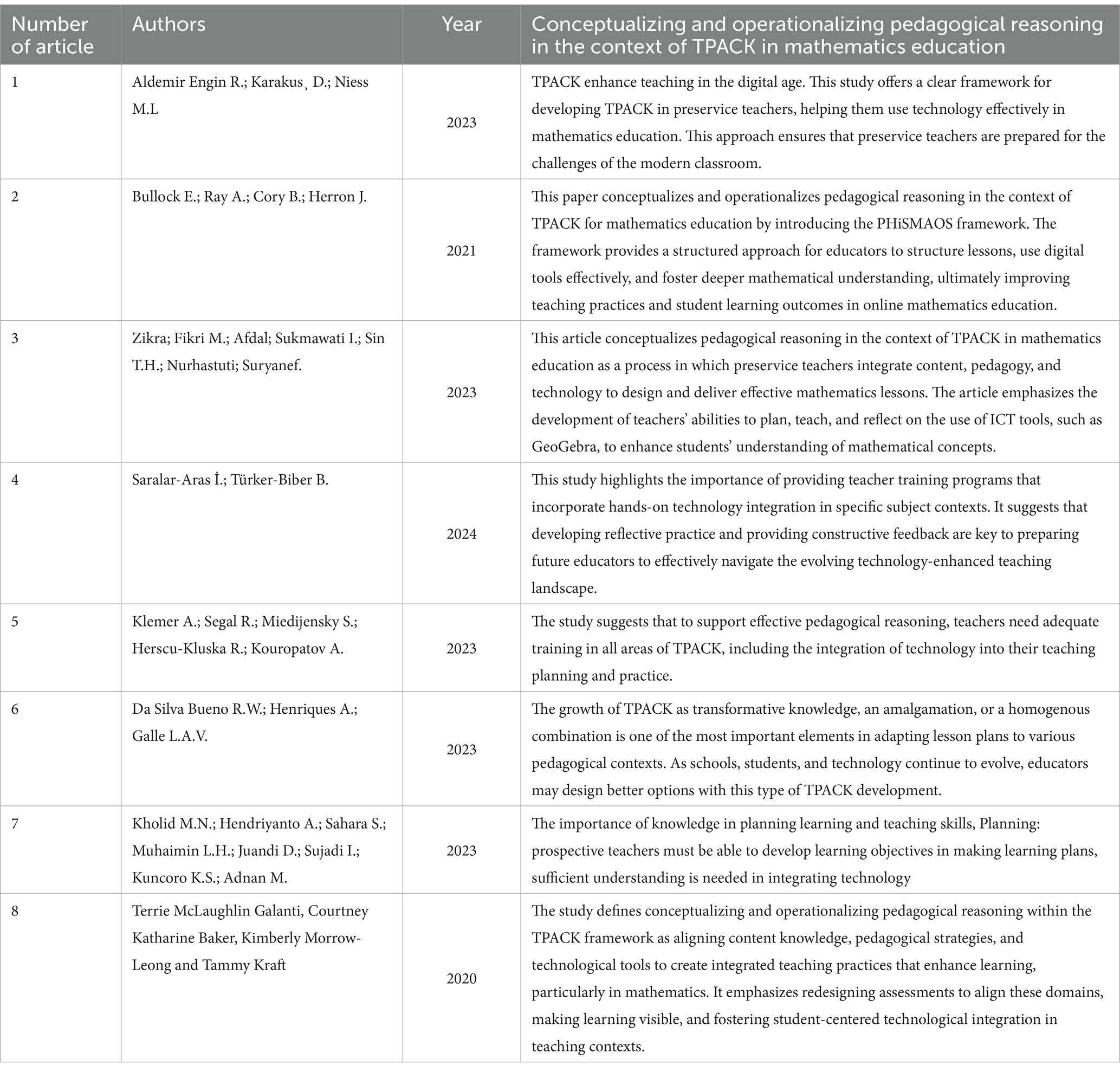
Table 2. Finding for conceptualizing and operationalizing pedagogical reasoning in the context of TPACK in mathematics education from selected articles.
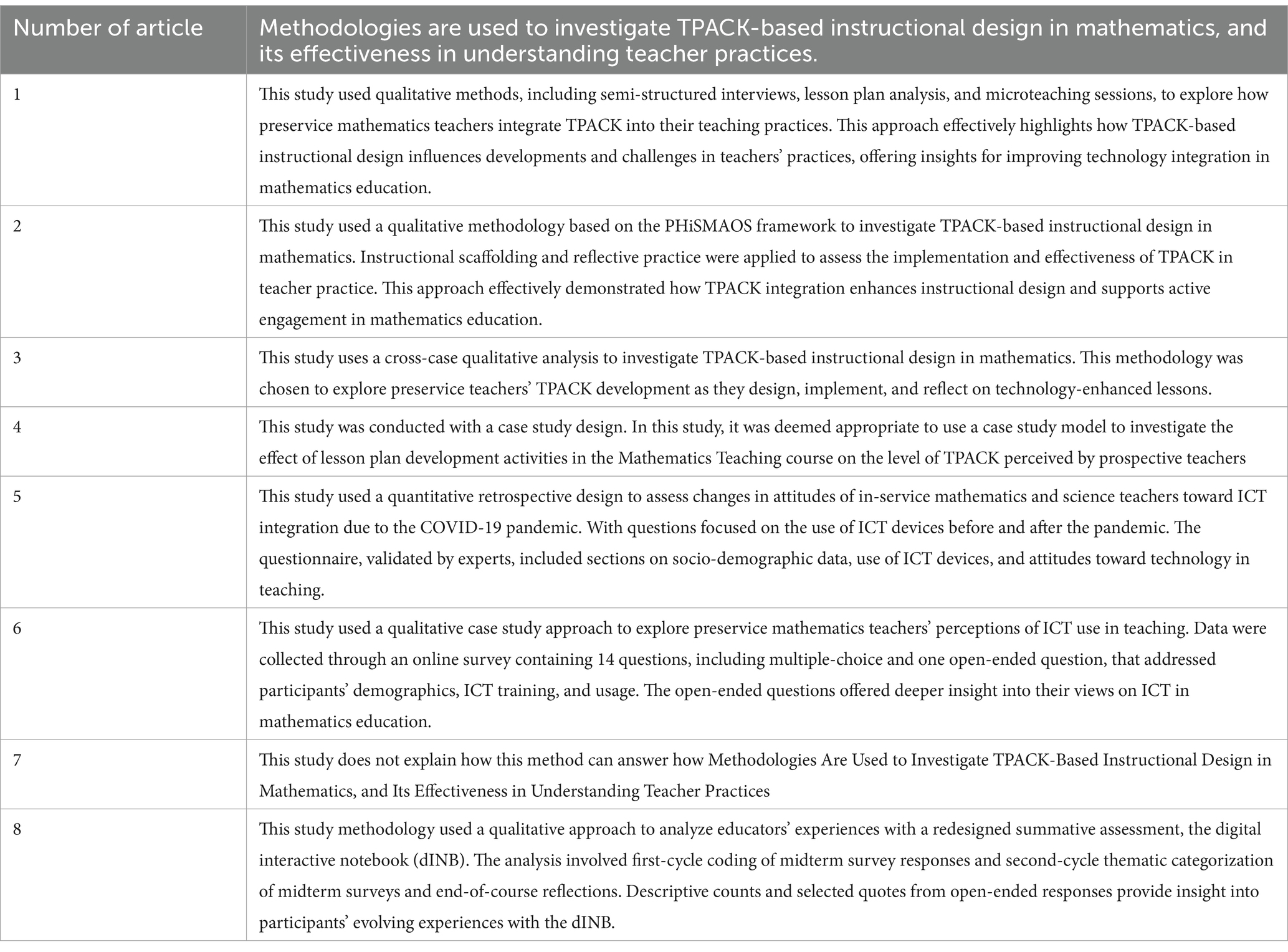
Table 3. Finding for methodologies are used to investigate TPACK-based instructional design in mathematics, and its effectiveness in understanding teacher practices from selected articles.
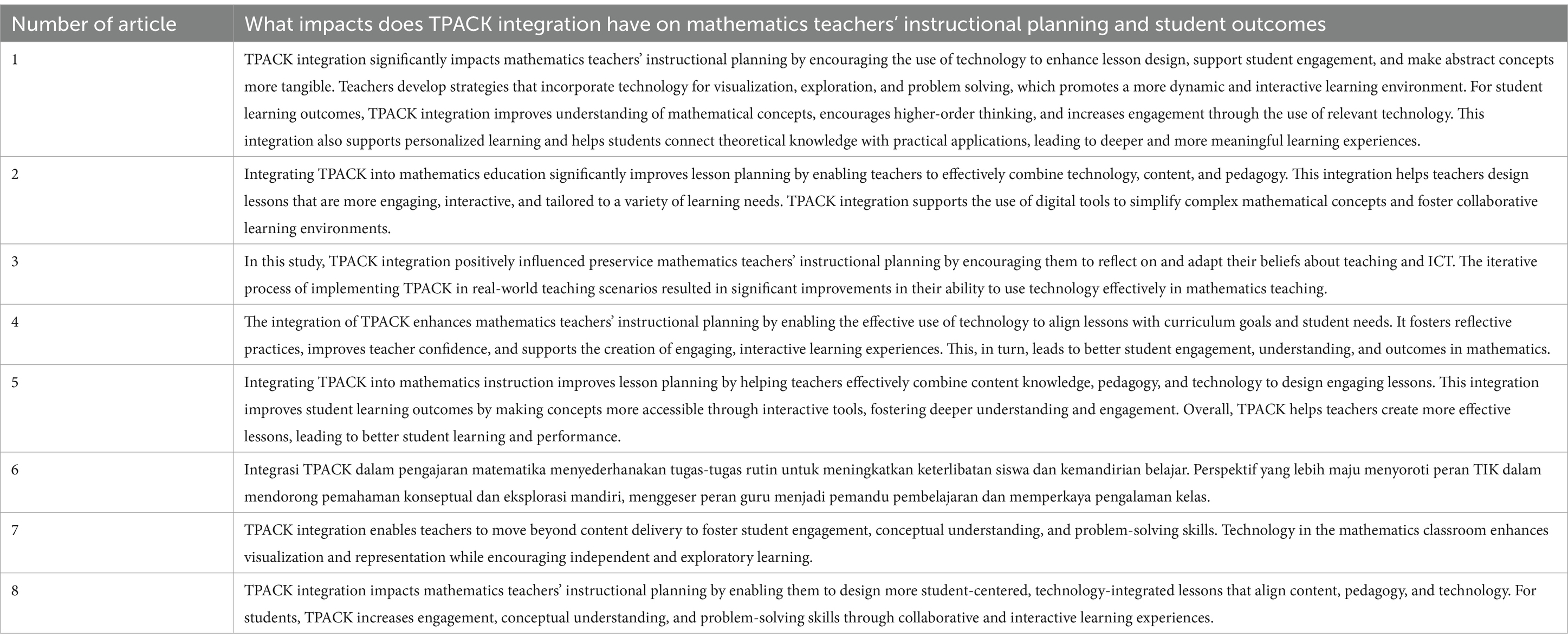
Table 4. Finding for what impacts does TPACK integration have on mathematics teachers’ instructional planning and student outcomes from selected articles.
Despite substantial advances in understanding and applying the TPACK framework within mathematics education. This section outlines the key areas where current literature is either limited or lacking, providing avenues for future exploration. While numerous studies have investigated TPACK’s impact on immediate instructional design, few have explored its long-term effects on pedagogical reasoning and teaching practices in mathematics. Understanding how TPACK knowledge evolves and integrates into sustained pedagogical reasoning over time is essential for assessing its effectiveness beyond short-term interventions. Future research could employ longitudinal studies to track changes in teachers’ pedagogical reasoning as they apply TPACK-based strategies consistently over several years. Furthermore, to see visualization trends in research directions that are developing and integrated with TPACK based on Co-Occurrence can be seen in Figure 4.
A network visualization of pedagogical reasoning in mathematics education using the TPACK framework provides a graphical representation of the relationships between key concepts and keywords in this domain. In this visualization, the nodes represent keywords, such as TPACK components (Technological Knowledge, Content Knowledge, Pedagogical Content Knowledge), and related ideas like pedagogical reasoning, distance learning, technology integration and instructional design. The connections, between teacher education, pre-service teacher, highlighting their interrelationships. The size of each node reflects the frequency of the keyword in the analyzed text, with more prominent terms appearing larger. Similarly, the thickness of the edges indicates the strength of the co-occurrence between two keywords, with thicker edges signifying stronger connections. Keywords that are closely related or frequently co-occurring tend to cluster together, forming thematic groups within the network. To see the development trend of countries where research is mostly integrated with TPACK, researchers use Scopus data and the results can be seen in Figure 5.
Figure 5 shows the most productive country in conducting research related to TPACK, namely the United States with a total of 523 documents, with 16,460 citations and spread across 106 journals, proceedings and the like which are indexed by Scopus. Furthermore, to see researchers who are widely used as references related to research using TPACK or based on Co-citation and content analysis can be seen in Table 5 below.
In Table 5 it can be seen that researchers who have become a source of reference for other researchers in integrated TPACK research are Mishrar P.; Koehler M. J. with a total of 4.114 citations.
5 Limitations
While this systematic review provides valuable insights into the integration of TPACK and pedagogical reasoning in mathematics education, several limitations should be acknowledged.
5.1 Database selection
This review relies exclusively on the Scopus database for article retrieval, which may limit the breadth of sources included. Although Scopus is a comprehensive database, it may exclude relevant studies published in other databases such as Web of Science, ERIC, or Google Scholar. Consequently, the findings may not fully represent the entire body of literature on TPACK and pedagogical reasoning. Future studies could broaden the database selection to capture a wider array of relevant publications, potentially increasing the generalizability of the findings.
5.2 Focus on recent literature
To maintain relevance, this review focused primarily on studies published within the last decade. While this approach ensures that the review reflects recent developments in TPACK and technology-enhanced mathematics instruction, it may overlook foundational studies and earlier theoretical work that contributed to the development of the TPACK framework. Including a broader historical perspective might offer more comprehensive insights into how TPACK has evolved over time and how foundational studies influenced current practices.
5.3 Scope and specificity of inclusion criteria
The inclusion criteria were designed to identify studies that specifically address TPACK, pedagogical reasoning, and mathematics education. While this focus allows for a targeted analysis, it may exclude studies that address relevant concepts under different terminologies or frameworks. For instance, research on technology integration, without explicit reference to TPACK, might also provide valuable insights but was not included in this review. As a result, the scope of the findings is limited to studies that explicitly employ TPACK as a framework, which may constrain the review’s applicability to broader contexts.
5.4 Methodological constraints in the literature
The existing literature on TPACK in mathematics education is predominantly qualitative, with limited longitudinal or experimental studies that investigate the sustained impacts of TPACK-based professional development. This methodological bias may limit the ability to draw causal inferences about the effects of TPACK on teacher practices and student outcomes. Additionally, self-reported data and case studies, while insightful, may be influenced by subjective bias, potentially affecting the reliability of the findings. Future research could address these limitations by incorporating more rigorous methodologies, such as longitudinal studies or randomized controlled trials, to provide stronger evidence of TPACK’s long-term effectiveness.
5.5 Variability in TPACK assessment tools
There is significant variability in how TPACK is assessed across studies, as no standardized instrument exists specifically for measuring TPACK in mathematics education. This lack of consistency makes it challenging to compare findings across studies, as different assessment tools may capture varying aspects of TPACK knowledge and skills. The reliance on diverse assessment methods, including self-reports, surveys, 961 and observational tools, introduces potential variability in the results. Future studies could benefit from the development and validation of a standardized TPACK assessment tool tailored to the unique demands of mathematics education, thereby enabling more accurate cross-study comparisons.
5.6 Potential for publication bias
As with any systematic review, there is a risk of publication bias, as studies with significant or positive findings are more likely to be published than those with null or negative results. This bias may skew the review’s conclusions, potentially overestimating the effectiveness of TPACK integration in mathematics education. Addressing this limitation requires future reviews to consider unpublished studies, theses, or conference papers where feasible, which may provide a more balanced view of the field.
5.7 Generalizability of findings
The findings of this review are specific to mathematics education and may not be directly transferable to other subject areas. While TPACK is a versatile framework applicable across disciplines, the challenges and strategies for technology integration in mathematics are unique and may not align with those in fields such as science or language arts. Further research could investigate TPACK applications in a variety of subjects, enabling a more comprehensive understanding of its applicability across diverse educational contexts. These limitations suggest directions for future research to build upon the current findings. By broadening the scope, improving methodological rigor, and developing standardized assessment tools, future studies can provide a more nuanced and robust understanding of TPACK’s role in enhancing pedagogical reasoning in mathematics education.
6 Conclusion
This systematic review highlights the critical role of the Technological Pedagogical Content Knowledge (TPACK) framework in enhancing pedagogical reasoning and instructional practices among mathematics educators. Findings indicate that TPACK provides a structured approach for integrating technology into mathematics education, allowing teachers to align technological tools with content and pedagogical objectives. Teachers who actively utilize TPACK demonstrate improved abilities to plan, implement, and adapt technology-based instructional designs that promote conceptual understanding, critical thinking, and engagement in mathematics classrooms (Koh, 2019).
The review reveals several key benefits of TPACK-based instruction. Teachers with well-developed TPACK skills are more adept at selecting technologies that enhance mathematical understanding, such as graphing software and interactive simulations, which support both procedural fluency and conceptual knowledge. Moreover, TPACK fosters inquiry-based learning by enabling teachers to create interactive and student-centered learning environments, facilitating active problem-solving and exploration. These approaches not only make abstract concepts more accessible, but also encourage students to engage deeply with mathematical content.
However, this review also identifies significant challenges in implementing TPACK. Teachers frequently encounter obstacles related to limited access to digital resources, varying levels of TPACK proficiency, and insufficient professional development tailored to mathematics education. The lack of standardized TPACK assessment tools further complicates efforts to measure teachers’ competencies and track professional growth effectively (You et al., 2019; Hoth et al., 2022). Addressing these issues requires ongoing institutional support, dedicated time for training, and policies that prioritize technology integration in educational curricula (Darling-Hammond, 2020).
In conclusion, TPACK holds significant potential to transform mathematics education by fostering technology-enhanced instructional practices that align with contemporary educational goals. By empowering teachers to use technology strategically, TPACK not only enhances instructional effectiveness but also prepares students with the critical thinking and problem-solving skills essential for success in an increasingly digital world. The insights from this review offer actionable recommendations for educators, policymakers, and researchers aiming to support effective technology integration in mathematics education, laying a foundation for further innovation in teaching and learning practices.
Data availability statement
The original contributions presented in the study are included in the article/Supplementary material, further inquiries can be directed to the corresponding author/s.
Author contributions
RP: Conceptualization, Data curation, Formal analysis, Methodology, Resources, Validation, Writing – review & editing. TH: Conceptualization, Investigation, Supervision, Writing – review & editing. RA: Data curation, Formal analysis, Investigation, Resources, Writing – review & editing. II: Conceptualization, Data curation, Formal analysis, Writing – original draft.
Funding
The author(s) declare that financial support was received for the research and/or publication of this article. The Indonesian Education Scholarship (BPI), Center for Higher Education Funding and Assessment (PPAPT), Kemdiktisaintek and Indonesian Endowment Fund for Education (LPDP) support this research.
Acknowledgments
The authors would like to express their deepest gratitude to the Indonesian Education Scholarship (BPI), Center for Higher Education Funding and Assessment (PPAPT), Kemdiktisaintek and Indonesian Endowment Fund for Education (LPDP). Authors also would like to express their sincere gratitude to all individuals and institutions whose support and contributions made this research possible.
Conflict of interest
The authors declare that the research was conducted in the absence of any commercial or financial relationships that could be construed as a potential conflict of interest.
Generative AI statement
The authors declare that no Gen AI was used in the creation of this manuscript.
Publisher’s note
All claims expressed in this article are solely those of the authors and do not necessarily represent those of their affiliated organizations, or those of the publisher, the editors and the reviewers. Any product that may be evaluated in this article, or claim that may be made by its manufacturer, is not guaranteed or endorsed by the publisher.
Supplementary material
The Supplementary material for this article can be found online at: https://www.frontiersin.org/articles/10.3389/feduc.2025.1552760/full#supplementary-material
References
Abrahamson, D., Nathan, M. J., Williams-Pierce, C., Walkington, C., Ottmar, E. R., Soto, H., et al. (2020). The future of embodied design for mathematics teaching and learning. Front. Educ. Front. Media SA 5:147. doi: 10.3389/feduc.2020.00147
Angeli, C., and Valanides, N. (2009). Epistemological and methodological issues for the conceptualization, development, and assessment of ICT-TPCK: advances in technological pedagogical content knowledge (TPCK). Comp. Educ. 52, 154–168. doi: 10.1016/j.compedu.2008.07.006
Angeli, C., and Valanides, N. (2015). Technological pedagogical content knowledge: Exploring, developing, and assessing TPCK. New York: Springer International Publishing.
Bokosmaty, S., Mavilidi, M. F., and Paas, F. (2017). Making versus observing manipulations of geometric properties of triangles to learn geometry using dynamic geometry software. Comput. Educ. 113, 313–326. doi: 10.1016/j.compedu.2017.06.008
Darling-Hammond, L. (2020). Accountability in teacher education. Action Teach. Educ. 42, 60–71. doi: 10.1080/01626620.2019.1704464
Demirhan, E., and Şahin, F. (2021). The effects of different kinds of hands-on modeling activities on the academic achievement, problem-solving skills, and scientific creativity of prospective science teachers. Res. Sci. Educ. 51, 1015–1033. doi: 10.1007/s11165-019-09874-0
Graham, C. R., Borup, J., and Smith, N. B. (2012). Using TPACK as a framework to understand teacher candidates’ technology integration decisions. J. Comput. Assist. Learn. 28, 530–546. doi: 10.1111/j.1365-2729.2011.00472.x
Herro, D., Visser, R., and Qian, M. (2021). Teacher educators’ perspectives and practices towards the technology education technology competencies (TETCs). Technol. Pedagog. Educ. 30, 623–641. doi: 10.1080/1475939X.2021.1970620
Hill, J. E., and Uribe-Florez, L. (2020). Understanding secondary school teachers’ TPACK and technology implementation in mathematics classrooms. Int. J. Technol. Educ. 3, 1–13. doi: 10.46328/ijte.v3i1.8
Hong, H. Y., and Chai, C. S. (2017). Principle-based design: development of adaptive mathematics teaching practices and beliefs in a knowledge building environment. Comput. Educ. 115, 38–55. doi: 10.1016/J.COMPEDU.2017.07.011
Hoth, J., Larrain, M., and Kaiser, G. (2022). Identifying and dealing with student errors in the mathematics classroom: Cognitive and motivational requirements. Front. Psychol. 13:1057730. doi: 10.3389/fpsyg.2022.1057730
Janson, A., Sӧllner, M., and Leimeister, J. M. (2020). Ladders for learning: is scaffolding the key to teaching problem-solving in technology-mediated learning contexts? Acad. Manag. Learn. Edu. 19, 439–468. doi: 10.5465/amle.2018.0078
Kelley, T. R., and Knowles, J. G. (2016). A conceptual framework for integrated STEM education. Int. J. STEM Educ. 3, 1–11.
Kimmons, R., Graham, C. R., and West, R. E. (2020). The PICRAT model for technology integration in teacher preparation. Contemp. Iss. Technol. Teach. Educ. 20, 176–198. Available at: https://citejournal.org/volume-20/issue-1-20/general/the-picrat-model-for-technology-integration-in-teacher-preparation
Koh, J. H. L. (2019). TPACK design scaffolds for supporting teacher pedagogical change. Educ. Technol. Res. Dev. 67, 577–595. doi: 10.1007/s11423-018-9627-5
König, J., Heine, S., Jäger-Biela, D., and Rothland, M. (2022). ICT integration in teachers’ lesson plans: A scoping review of empirical studies. Eur. J. Teach. Educ. 47, 821–849. doi: 10.1080/02619768.2022.2138323
Kunwar, R., and Laxmi, G. C. (2023). An Overview of strategies for conceptualizing derivative and their applications in daily life for secondary-level mathematics students. South Asian Res. J. Eng. Tech. 5, 69–82. doi: 10.36346/sarjet.2023.v05i05.003
Martin, B. (2015). Successful implementation of TPACK in teacher preparation programs. Int. J. Integ. Technol. Educ. 4, 17–26. doi: 10.5121/ijite.2015.4102
Mayer, P., and Girwidz, R. (2019). Physics teachers’ acceptance of multimedia applications—adaptation of the technology acceptance model to investigate the influence of TPACK on physics teachers’ acceptance behavior of multimedia applications. Front. Educ. 4:73. doi: 10.3389/feduc.2019.00073
McDougall, T., and Phillips, M. (2024). Contextual considerations in TPACK: collaborative processes in initial teacher education. Comp. Educ. Open 7:100207. doi: 10.1016/j.caeo.2024.100207
Meneses, A., Nussbaum, M., Veas, M. G., and Arriagada, S. (2023). Practice-based 21st-century teacher education: design principles for adaptive expertise. Teach. Teach. Educ. 128:104118. doi: 10.1016/j.tate.2023.104118
Mishra, M., Gorakhnath, I., Lata, P., Rani, R., and Chopra, P. (2022). Integration of technological pedagogical content knowledge (TPACK) in classrooms through a teacher’s lens. Int. J. Health Sci. 6, 12505–12512. doi: 10.53730/ijhs.v6nS3.9536
Mishra, P., and Koehler, M. J. (2006). Technological pedagogical content knowledge: a framework for teacher knowledge. Teachers College Record 108, 1017–1054. doi: 10.1177/016146810610800610
Niess, M. L. (2005). Preparing teachers to teach science and mathematics with technology: developing a technology pedagogical content knowledge. Teach. Teach. Educ. 21, 509–523. doi: 10.1016/j.tate.2005.03.006
Niess, M. L. (2015). Transforming teachers’ knowledge: learning trajectories for advancing teacher education for teaching with technology. In: Technological Pedagogical Content Knowledge. (eds) C. Angeli and N Valanides. (Boston, MA: Springer), doi: 10.1007/978-1-4899-8080-9_2
Niess, M. L., and Gillow-Wiles, H. (2017). Expanding teachers’ technological pedagogical reasoning with a systems pedagogical approach. Australas. J. Educ. Technol. 33, 77–95. doi: 10.14742/ajet.3473
Özen, E., and Kurtuluş, A. (2023). A study on mathematics teachers’ technological pedagogical content knowledge (TPACK) and frequency of use of educational information network (EBA) assessment tools. J. Educ. Technol. 6, 1009–1026.
Page, M. J., McKenzie, J. E., Bossuyt, P. M., Boutron, I., Hoffmann, T. C., Mulrow, C. D., et al. (2021). The PRISMA 2020 statement: an updated guideline for reporting systematic reviews. BMJ 372. doi: 10.1136/bmj.n71
Petko, D., Mishra, P., and Koehler, M. J. (2025). TPACK in context: an updated model. Computers Education Open 8:100244. doi: 10.1016/j.caeo.2025.100244
Phuong, H. T. M. (2020). Measuring conceptual understanding, procedural fluency and integrating procedural and conceptual knowledge in mathematical problem solving. Int. J. Sci. Res. Manag. 8, 212–218.
Rakes, C. R., Stites, M. L., Ronau, R. N., Bush, S. B., Fisher, M. H., Safi, F., et al. (2022). Teaching mathematics with technology: TPACK and effective teaching practices. Educ. Sci. 12:133. doi: 10.3390/educsci12020133
Russ, R. S., Sherin, B., and Sherin, M. G. (2011). “Images of expertise in mathematics teaching” in Expertise in mathematics instruction: An international perspective (Boston, MA.: Springer US), 41–60.
Schmidt, D. A., Baran, E., Thompson, A. D., Mishra, P., Koehler, M. J., and Shin, T. S. (2009). Technological Pedagogical Content Knowledge (TPACK): the development and validation of an assessment instrument for preservice teachers. J. Res. Technol. Educ. 42, 123–149. doi: 10.1080/15391523.2009.10782544
Seng, J. J., Chai, C. S., Tan, L., and Park, M. (2022). A critical review of research on technological pedagogical and content knowledge (TPACK) in language teaching. Comput. Assist. Lang. Learn. 35, 948–971. doi: 10.1080/09588221.2020.1868531
Shi, Y., Hong, D., Cai, Y., Shao, P., and Hughes, J. E. (2019). Teaching educational technology: an analysis of course syllabi from teacher education programs. 42nd Annual Proceedings 1:236.
Shulman, L. S. (1987). Knowledge and teaching: foundations of the new reform. Harv. Educ. Rev. 57, 1–23. doi: 10.17763/haer.57.1.j463w79r56455411
Tallman, M. A. (2021). Investigating the transformation of a secondary teacher’s knowledge of trigonometric functions. J. Mathematical Behavior 62:100869. doi: 10.1016/j.jmathb.2021.100869
Trust, T., Krutka, D. G., and Carpenter, J. P. (2016). “Together we are better”: professional learning networks for teachers. Comput. Educ. 102, 15–34. doi: 10.1016/j.compedu.2016.06.007
Voogt, J., Fisser, P., Pareja Roblin, N., Tondeur, J., and van Braak, J. (2013). Technological pedagogical content knowledge - a review of the literature. J. Comput. Assist. Learn. 29, 109–121. doi: 10.1111/j.1365-2729.2012.00487.x
Webb, N. M., Franke, M. L., Ing, M., Turrou, A. C., Johnson, N. C., and Zimmerman, J. (2019). Teacher practices that promote productive dialogue and learning in mathematics classrooms. Int. J. Educ. Res. 97, 176–186. doi: 10.1016/j.ijer.2017.07.009
Widiana, F. H., and Rosy, B. (2021). Pengembangan E-Modul Berbasis flipbook maker pada Mata Pelajaran Teknologi Perkantoran. Edukatif 3, 3728–3739. doi: 10.31004/edukatif.v3i6.1265
Yang, Q. F., Lin, C. J., and Hwang, G. J. (2021). Research focuses and findings of flipping mathematics classes: a review of journal publications based on the technology-enhanced learning model. Interact. Learn. Environ. 29, 905–938. doi: 10.1080/10494820.2019.1637351
Yeh, Y., Kam, K., Chan, H., and Hsu, Y. (2021). Computers & education toward a framework that connects individual TPACK and collective TPACK: a systematic review of TPACK studies investigating teacher collaborative discourse in the learning by design process. Comput. Educ. 171:104238. doi: 10.1016/j.compedu.2021.104238
Keywords: instructional design, mathematics education, pedagogical reasoning, teachers’ knowledge, TPACK
Citation: Priyanda R, Herman T, Amalia R and Ihsan IR (2025) Exploring teachers’ pedagogical reasoning in mathematics education using the TPACK framework. Front. Educ. 10:1552760. doi: 10.3389/feduc.2025.1552760
Edited by:
Michael Tallman, Oklahoma State University, United StatesReviewed by:
Alfiya R. Masalimova, Kazan Federal University, RussiaKaan Bati, Hacettepe University, Türkiye
Copyright © 2025 Priyanda, Herman, Amalia and Ihsan. This is an open-access article distributed under the terms of the Creative Commons Attribution License (CC BY). The use, distribution or reproduction in other forums is permitted, provided the original author(s) and the copyright owner(s) are credited and that the original publication in this journal is cited, in accordance with accepted academic practice. No use, distribution or reproduction is permitted which does not comply with these terms.
*Correspondence: Tatang Herman, dGF0YW5naGVybWFuQHVwaS5lZHU=
 Roni Priyanda
Roni Priyanda Tatang Herman
Tatang Herman Rizki Amalia
Rizki Amalia Iden Rainal Ihsan
Iden Rainal Ihsan